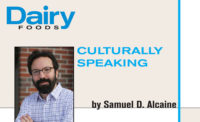Fermented dairy could have a place in the alcohol aisle
If plants can find success in markets built on dairy, why can’t dairy find success in the alcoholic beverage arena — a market built on plants?

Dairy is one of the coolest — if not the coolest — food categories in the grocery store. How do I know? Because every time I walk down the dairy aisle, I see another food trying to get into its space.
One day it’s the oats trying to get in with coffee and milk; next it’s the coconuts calling to hang out with the yogurt. And what they do to get face time with the big cheese is just nutty.
They say imitation is the sincerest form of flattery, but in this competitive marketplace, perhaps it’s time for dairy to stop looking at who’s trying photobomb its selfies and start looking for opportunities to grow around the store.
Once I’ve stocked up on my milk, cheddar and skyr, it seems like I have to walk a few miles to pick up my six-pack of beer. I know in some states, dairy and alcohol are not even in the same store, so it can be easy to miss all the consumer-driven change going on there. Over the past decade, producers of craft beer and craft spirits have multiplied like Tribbles, creating a kaleidoscope of innovative flavors and products.
But when you walk down these alcohol aisles, you almost never see dairy. Sure, there might be a Baileys in the corner or a milk stout tucked into the back of the shelf, but for the most part, zilch.
Ingredients for success
Why not? Alcohol just takes sugar from plants and uses microbiology to convert it into ethanol, and we have a lot of excess sugar in dairy. We’ve got dairy yeast such as Kluyveromyces that can ferment that lactose into ethanol. We’ve got dairy enzymes such as lactase to break lactose into simple sugars for traditional beer/wine yeast to make ethanol. My lab has even shown that barley enzymes or nontraditional beer/wine yeast can be used to turn lactose into ethanol.
There are so many processes at our fingertips to create new beverages that can be flavored, distilled, blended and aged to engage and delight consumers.
I’m not the only one who sees this opportunity. In Canada, the U.K., New Zealand and Oregon, there are already visionaries bringing this spirit to life by fermenting and distilling dairy byproducts. I’ve had the opportunity to taste a few, and even in forms as neutral as vodka, these dairy-based spirits are not copies, but appreciably unique among their counterparts in flavor and smoothness. Nestled here in my Finger Lakes, a little brewery
is taking a leap by fermenting acid whey, spiced with hops and blended with fruits, to create a tart, refreshing addition for summer travelers along the wine and beer trails.
Untapped potential
These ventures might be small, but I’d argue there’s a large untapped potential. Here’s a thought exercise: From 2005 to 2015, the Greek yogurt industry exploded from less than 2% of the market to 36%, producing over 750,000 metric tons yearly and generating upwards of 600 million gallons of acid whey that had nowhere great to go. Over the same decade, craft beer took its market share from under 3% to over 14%, an increase in yearly volumes of approximately 600 million gallons.
Coincidence? Perhaps. But that craft beer market increase was worth over $23 billion dollars.
I know you can’t simply swap one market cup for another, but imagine if dairy had made an effort to play in that space with whey. If plants can find success in markets built on dairy, why can’t dairy find success in a market built on plants? I think a six-pack would make a great new case for dairy.
Looking for a reprint of this article?
From high-res PDFs to custom plaques, order your copy today!






